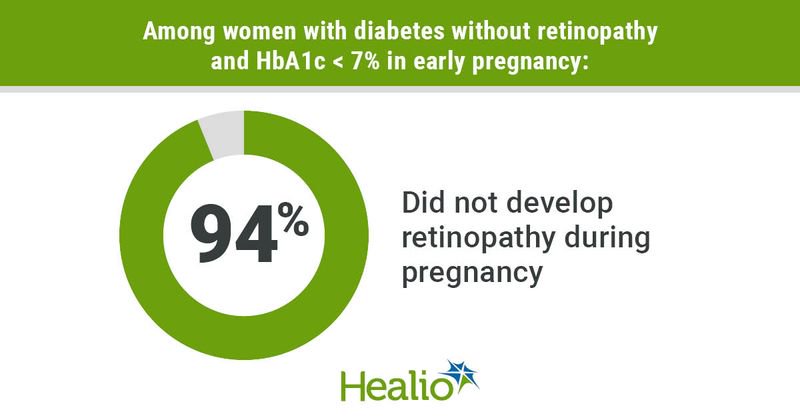Sight-threatening retinopathy rare for pregnant women with well-controlled diabetes
Pregnant women with preexisting diabetes and an HbA1c of less than 7% in early pregnancy rarely develop sight-threatening retinopathy and can safely undergo less retinal screening, according to study findings published in Diabetic Medicine.
“Management of preexisting diabetes during pregnancy imposes a lot of extra daily challenges on the women and frequent hospital visits,” Elisabeth Reinhardt Mathiesen, MD, DMSc, clinical professor in the department of clinical medicine at the University of Copenhagen and chief physician in the department of endocrinology and metabolism at Rigshospitalet in Denmark, and colleagues wrote. “Therefore, it seems reasonable to individualize their antenatal care programs and reduce the amount of unnecessary hospital visits as proposed in international guidelines. This paper is the first to validate a safe and pragmatic method for selecting pregnant women for reduced screening frequency.”

Researchers analyzed data from 348 women with preexisting diabetes and a singleton pregnancy referred to the Center for Pregnant Women with Diabetes at Rigshospitalet from September 2015 to February 2020. Retinal screening was performed at 12 and 27 weeks of pregnancy. Participants were classified as having no retinopathy, nonproliferative diabetic retinopathy or sight-threatening retinopathy. Those with severe nonproliferative retinopathy, proliferative retinopathy or clinically significant macular edema underwent repeated photo screening or an examination from an ophthalmologist.
Of the study cohort, 223 women had type 1 diabetes and 125 had type 2 diabetes. Of those with type 1 diabetes, 52% had retinopathy in pregnancy. Sight-threatening retinopathy was prevalent in 16%, proliferative retinopathy was observed in 7% of eyes during early pregnancy screening and an additional 1% of eyes progressed to proliferative retinopathy during pregnancy. Clinically significant macular edema was observed in 5% of eyes during early pregnancy, and an additional 2% develop clinically significant macular edema during pregnancy.
Of those with type 2 diabetes, 14% had retinopathy in pregnancy. Sight-threatening retinopathy was found in 6% of women with type 2 diabetes. Proliferative retinopathy was found in 2% of individual eyes of those with type 2 diabetes during early pregnancy. One additional eye progressed to proliferative retinopathy during pregnancy. There were no cases of clinically significant macular edema found in early pregnancy, and three individual eyes progressed to clinically significant macular edema during pregnancy.
The proportion of women with no retinopathy and an HbA1c of less than 7% in early pregnancy was 42% of those with type 1 diabetes and 65% of those with type 2 diabetes. None of the women with an HbA1c of less than 7% and without retinopathy in early pregnancy developed sight-threatening retinopathy, and 94% remained without any type of retinopathy during pregnancy. Of those without retinopathy and an HbA1c of 7% or higher in early pregnancy, none developed proliferative retinopathy, one developed clinically significant macular edema and 93% remained without retinopathy.
“The clinical implication of this study may involve a change in practice with a delay of further retinal examinations to postpartum if no retinopathy is found at the first retinal examination during pregnancy and good glycemic control, defined as HbA1c less than 7%, is present in early pregnancy,” the researchers wrote. “Based on the findings of the present study, approximately 50% of photo screenings in late pregnancy would thus no longer be necessary at our center. Regular screening of women with mild to severe retinal changes in early pregnancy is still advisable.”
